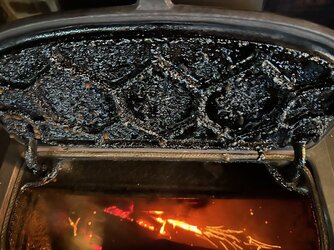Hello! Sorry if im asking questions that have been asked before. Ive been trying to find good instructions for this stove online and they all seem to only talk about initial starting of the stove.
Let me start from the top, I just purchased my first house and it contained a VC Vigilant 1977 wood stove. Ive never had or used a wood stove before so i really didn't plan to use it until i got my first electric bill of 1200$ for heating(heat pump was broken and using AUX heat entire time).
Fast forward to 2 weeks ago. I had a new flue(8 inch) installed, had the stove cleaned, then i got 2 cords of 2 year seasoned wood delivered. (Hats off to you guys stacking all this wood, been chipping away at it for over a week now).
Now onto my process, I take some kindling, some logs. I open the flap in the back, open the damper(horizontal mode), Open the secondary combustion chamber hole(little hole on left side). I light the logs, keep door cracked until it catches. Then when it has a good flame i close the door. I wait for the wood stove surface temp to reach around 500 then close the damper(vertical mode)
So i think i have the above process correct, now comes the efficiency. I want to run at a lower temp but also efficiently. Apparently that has to do with the secondary combustion chamber.
So my question is, after i close the damper, what should i do with the secondary combustion flap, do i leave it open? closed? How do i know if the stove is running in secondary combustion mode. I assume secondary combustion mode is to make the stove more efficient.
Also is there a minimum stove temp recommended when running this stove? since its not that cold out ive been running stove around 200 degrees and i noticed alot of black build up in the stove, it looks like tear drops on the top loading lid. Ive attached a picture of it.

Let me start from the top, I just purchased my first house and it contained a VC Vigilant 1977 wood stove. Ive never had or used a wood stove before so i really didn't plan to use it until i got my first electric bill of 1200$ for heating(heat pump was broken and using AUX heat entire time).
Fast forward to 2 weeks ago. I had a new flue(8 inch) installed, had the stove cleaned, then i got 2 cords of 2 year seasoned wood delivered. (Hats off to you guys stacking all this wood, been chipping away at it for over a week now).
Now onto my process, I take some kindling, some logs. I open the flap in the back, open the damper(horizontal mode), Open the secondary combustion chamber hole(little hole on left side). I light the logs, keep door cracked until it catches. Then when it has a good flame i close the door. I wait for the wood stove surface temp to reach around 500 then close the damper(vertical mode)
So i think i have the above process correct, now comes the efficiency. I want to run at a lower temp but also efficiently. Apparently that has to do with the secondary combustion chamber.
So my question is, after i close the damper, what should i do with the secondary combustion flap, do i leave it open? closed? How do i know if the stove is running in secondary combustion mode. I assume secondary combustion mode is to make the stove more efficient.
Also is there a minimum stove temp recommended when running this stove? since its not that cold out ive been running stove around 200 degrees and i noticed alot of black build up in the stove, it looks like tear drops on the top loading lid. Ive attached a picture of it.


